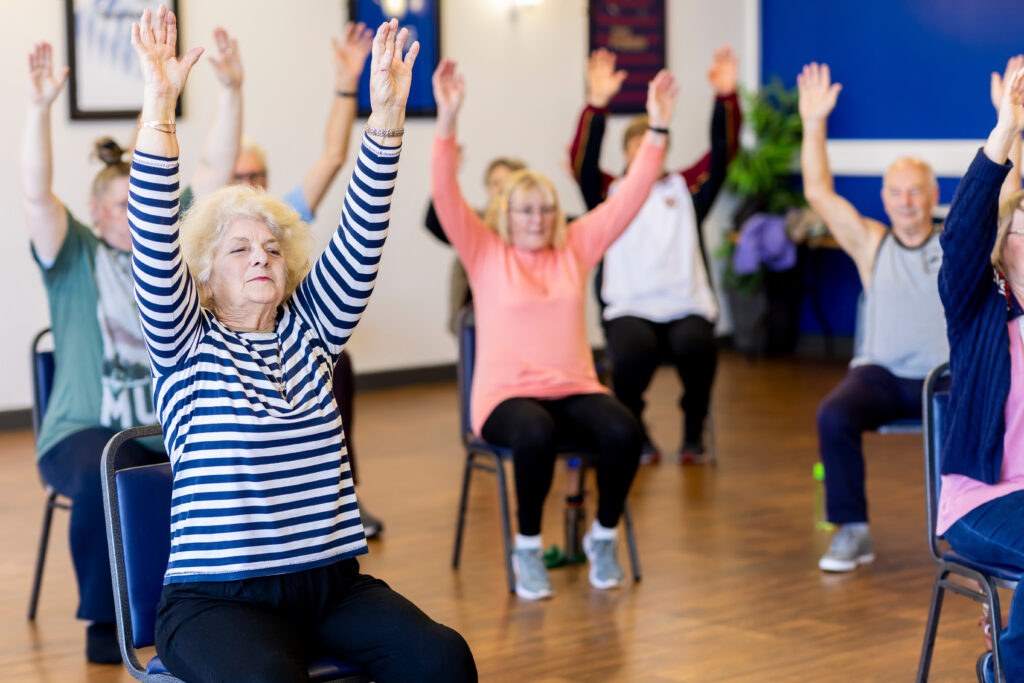
Realistic exercise goals for women as we age
The Australian Guidelines to Physical Activity recommend how much we should move to maintain good health.
Here’s what the guidelines say: For adults below the age of 65, we should aim to be active most days, preferably every day.
- We are ideally doing 2.5 to 5 hours of moderate activity or 1.25 to 2.5 hours of vigorous activity every week.
- We should aim to include muscle strengthening activities, such as lifting weights, two days per week. This keeps our bones and muscles strong as we age.
For adults over the age of 65, we should do at least 30 minutes of moderate to vigorous physical activity on most days, preferably every day.
Daily tasks such as cleaning, walking places and carrying shopping count as moving, but it is also good to set some time aside to do an intentional activity – some suggestions are set out below.
Activity types
Moderate activities
- Brisk walking
- Swimming
- Golf
- Cycling
- Tennis
- Water aerobics
- Yard or garden work
- Mopping and vacuuming

Vigorous activites
Muscle strengthening activities
- Jogging
- Aerobics
- Soccer
- Netball
- Gym exercises
- Weight, strength and resistance training
- Climbing stairs
- Push ups, pull ups, squats and lunges
- Gym exercises
Do what’s right for you and your body
Being new to keeping active or having a barrier that might impact our ability to be active, means that we need to be realistic with our goals. We need to choose activities that are enjoyable but are also appropriate for our bodies and abilities.
If you are not engaging in much physical activity right now, trying to meet the Australian Guidelines on Physical Activity may not be achievable just yet – and that’s okay. We are not aiming for perfection, but rather doing what makes us feel good and works best for us individually. The guidelines should be used to celebrate movement and support our health and wellbeing, not as a rigid set of rules.
Start with small steps. Maybe a 10-minute walk every second morning and then adding a bit more time each week until you’re up to 30 minutes. Joining a local walking group can be a fun way to make friends and stay motivated.
Below are two videos by Exercise Right. Here, you can learn more about setting realistic exercise goals for you, and watch Fay talk about doing exercise that is right for her and her health.
The Victorian Council of the Aged offers helpful resources about moving and staying active, with accessible exercises for strength, balance, mobility, back health and yoga. You can also find links to social groups near you.
If you’re thinking about increasing your activity levels, it’s always a good idea to speak to your doctor about your personal health needs first.
Using a pre-exercise screening tool
This adult pre-exercise screening tool from AusActive helps you understand if you might need some extra care or if you should speak to your doctor before beginning a new exercise routine.
If you’d like to learn more, then these resources may help:
Bauman, A., Merom, D., Bull, F. C., Buchner, D. M., & Singh, M. A. F. (2016). Updating the evidence for physical activity: summative reviews of the epidemiological evidence, prevalence, and interventions to promote "active aging". The Gerontologist, 56(S2), S268-S280.
Wallbank G, Sherrington C, Hassett L, et al. (2020) Active Women over 50 online information and support to promote physical activity behaviour change: study protocol for a pilot trial. Pilot Feasibility Studies. 6(91).
Wallbank G, Sherrington C, Hassett L, et al. (2022) Active women over 50: promoting physical activity in women over 50: a randomized trial. American Journal of Health Promotion. 2022;36(2): 305-309.
Izquierdo M, Merchant RA, Morley JE, et al. (2021). International exercise recommendations in older adults (ICFSR): expert consensus guidelines. The Journal of Nutrition, Health and Ageing. 25(7): 824-853. https://doi.org/10.1007/s12603-021-1665-8.
Better Health Channel (2022). Physical activity for seniors. Retrieved from https://www.betterhealth.vic.gov.au/health/healthyliving/physical-activity-for-seniors
Langhammer B, Bergland A, Rydwik E (2018). The importance of physical activity exercise among older people. Biomed Research International. 2018: 7856823 https://doi.org/10.1155/2018/7856823
Department of Health and Aged Care (2021). Physical activity and exercise guidelines for all Australians. Retrieved https://www.health.gov.au/topics/physical-activity-and-exercise/physical-activity-and-exercise-guidelines-for-all-australians/for-adults-18-to-64-years
Better Health Channel (2022). Physical activity – how to get started. Retrieved from https://www.betterhealth.vic.gov.au/health/healthyliving/physical-activity-how-to-get-started
HM (2002) Effects of Tai Chi exercise on balance, functional mobility, and fear of falling among older women. Applied Nursing Research. 15(4): 253-242 https://doi.org/10.1053/apnr.2002.35975
Department of Health and Aged Care (2022). For people with disability or chronic conditions. Retrieved https://www.health.gov.au/topics/physical-activity-and-exercise/physical-activity-and-exercise-guidelines-for-all-australians/for-people-with-disability-or-chronic-conditions
Cheung C (2014). Yoga for managing knee osteoarthritis in older women: a pilot randomized controlled trial. BMC Complementary and Alternative Medicine. 14(1): 160 https://doi.org/10.1186/1472-6882-14-160
Thomas E, Battaglia G, Patti A, et al. (2019). Physical activity programs for balance and fall prevention in elderly: a systematic review. Medicine (Baltimore). 98(27) https://doi.org/10.1097/MD.0000000000016218
Wolf R, Locks P, Lopes PB, et al. (2020). Multicomponent exercise training improves gait ability of older women rather than strength training: a randomized controlled trial. Journal of Ageing Research. https://doi.org/10.1155/2020/6345753 Lee YS (2005).
Gender differences in physical activity and walking among older adults. Journal of Women and Aging. 17(1):55-70 https://doi.org/ 10.1300/J074v17n01_05
UN Women 2023,Safe Cities and Safe Public Spaces – At a Glance. https://www.unwomen.org/sites/default/files/Headquarters/Attachments/Sections/How%20We%20Work/flagship%20programmes/UN-Women-Flagship-programme-Safe-cities-public-spaces-en.pdf





